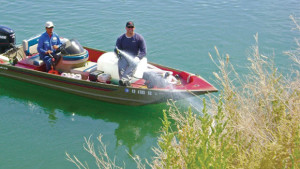Weed Control on the Rise in Noncrop
 The task of protecting crops from weeds is so immense it can be easy to forget that weeds present a set of risk factors completely separate from the agricultural space. For companies more focused on ag, opportunities are rising in the noncrop sector as many products cross over from one to the other.
The task of protecting crops from weeds is so immense it can be easy to forget that weeds present a set of risk factors completely separate from the agricultural space. For companies more focused on ag, opportunities are rising in the noncrop sector as many products cross over from one to the other.
Wildfires, reduction of line of sight on railroads and highways, flooding and drop of land values are just some the factors driving the sector’s growth. Weeds impede such activities as moving electricity across power lines, keeping grazing lands available to fatten cattle, replanting harvested forest land, and maintaining inland water bodies so they are clean, safe and available for recreation.
Growth of the IVM market, which is worth about $1 billion globally, has been gaining slowly but steadily, according to a new report by Kline and Company, “Global Industrial Vegetation Management of Pesticides and Fertilizers: Market Analysis and Opportunities.”
In October, Bayer CropScience acquired some of DuPont’s land management assets geared toward helping land managers and utility foresters control weeds and brush in the United States, Canada, Mexico, Australia and New Zealand. DuPont, one of the market’s top suppliers, has about 30 herbicides in its portfolio including Perspective (aminocyclopyrachlor + chlorsulfuron), Streamline (aminocyclopyrachlor + metsulfuron), Escort (metsulfuron) and Oust (sulfometuron) that will complement Bayer’s offering and garner it market share. Armed with its flagship Esplanade indaziflam herbicide, Bayer only entered the IVM market in 2012 and posted about $38 million in sales in 2013. The addition of the much larger DuPont business, which did $64 million in sales in the same period, vaults Bayer into a strong number-two position behind Dow AgroSciences.
Most products are developed for the agricultural market and are able to cross over to IVM. As a niche space, IVM scouts out the most desired characteristics, such as selectivity and long-term control, says Matt Nespeca, head of Bayer’s Vegetation Management business.
As the IVM market evolves, it moves increasingly toward specificity – herbicides that are most selective for the weeds targeted, says Dennis Fugate, who authored the Kline report. Specially developed combination products have helped to fend off generic price competition. For example, Dow has created several strong combination products, especially in the range and pasture market, to maintain market share.
Compounds to control unwanted brush are also highly specific. Products must be effective for long-term control, between two and five years.
The IVM market is a mature one lacking innovation in recent years, Nespeca says. But new technology is becoming increasingly important, as IVM faces many of the same challenges as the crop protection industry, including weed resistance. DuPont’s range of new modes of action – along with the 16 highly experienced employees Bayer gained from the company – are key parts of the equation, he stressed.
“Land managers, applicators and land owners are looking for new solutions, and it’s a pretty bright future ahead … New technologies will be a significant driver,” and Bayer will look to launch a new product from its pipeline every year, Nespeca told FCI.
What Will Keep Driving the Market
The leading countries practicing in IVM are the United States, Brazil, Australia and Japan. The largest end-use segment globally is range and pasture, representing about 40% of total sales to the IVM segment, followed by right-of-way (roads, pipelines and railways) management accounting for an estimated 35% of the total, according to the Kline and Company study.
Competition from generics has forced a response, Fugate says. In 2013 in the U.S., nearly 25% of IVM products in terms of value were supplied by generic companies such as MANA (now Adama) and Nufarm.
“The biggest success story has probably been Adama’s (U.S.-based subsidiary) Alligare, which started as a generic marketer selling to right-of-way customers and morphed into a major player across the IVM spectrum,” Fugate told FCI. Dow has used its Milestone product based on the active ingredient aminopyralid, in addition to many new combination products that fit individual niches to differentiate from generics. In the last decade, Milestone has more than doubled its share because it is highly effective and has application characteristics that meet safety and environmental needs, Fugate says. BASF has become less of a factor in this segment as its AIs have gone off patent, he added.
What will keep driving the market, says Fugate, are several factors. One is increased drilling in the oil and gas industries, which continues to spur herbicide use due to the necessity of vegetation management along pipelines and around drilling sites. In addition, invasive weeds are spreading and becoming more of a problem, particularly in the West. In many cases, the U.S. government has mandated that specific invasive weeds be treated. Chemical mowing has also increased in importance in recent years due to the high labor cost associated with mowing.
However, the economic slowdown has led to budget cuts and decreased funding for vegetation management projects. The sluggish housing market also continues to be a drag on the forestry industry, and more specifically, forestry herbicide usage.
“Regardless of the economy,” Nespeca says, “the one thing we do know is that in the U.S., infrastructure continues to grow, and as infrastructure grows, whether it be roads, pipelines, industrial sites, wind farms and solar farms, vegetation has the potential to cause significant harm if left unmanaged.”
The overriding message, says Nespeca, “is that our job is to protect people and infrastructure from detrimental vegetation. That risk is how we’re defining our platform. We are excited to take this (merger) into the future.”






